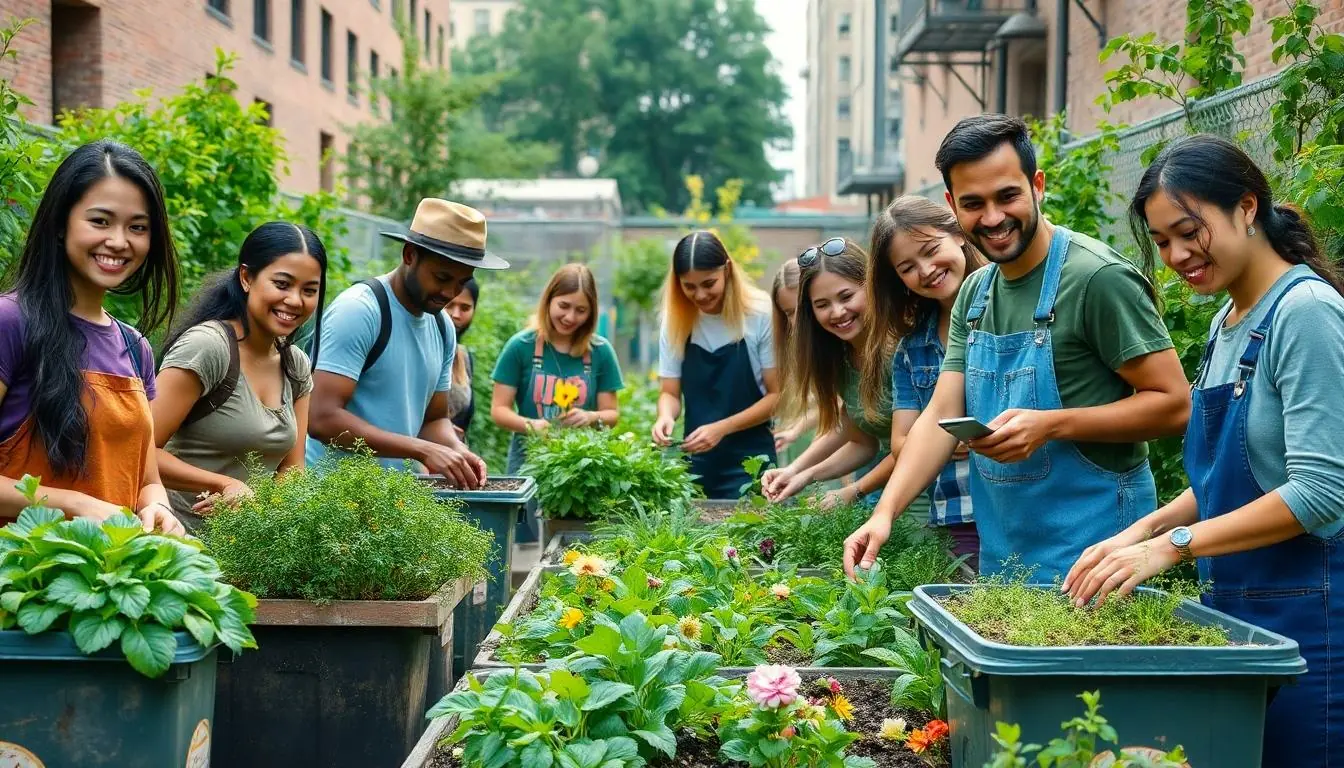Table of Contents
ToggleIn a world where plastic seems to multiply faster than rabbits, sustainable living solutions have become the superheroes we never knew we needed. Forget the cape; it’s all about reusable bags, energy-efficient appliances, and composting like a pro. Embracing sustainability isn’t just good for Mother Earth; it’s a savvy way to save some green in your wallet too.
Imagine sipping your morning coffee from a stylish, eco-friendly mug while knowing you’re doing your part to keep the planet happy. It’s not just a trend; it’s a lifestyle choice that promises a brighter future. So why not dive into the world of sustainable living? You’ll discover practical tips and tricks that make going green not only easy but downright enjoyable. Who knew saving the planet could be this much fun?
Overview of Sustainable Living Solutions
Sustainable living solutions encompass a range of practices aimed at reducing environmental impact. Reusable bags represent one simple adjustment, reducing reliance on single-use plastics. Energy-efficient appliances contribute to lowering energy consumption, ultimately leading to significant cost savings. Composting kitchen waste transforms organic matter into nutrient-rich soil, benefiting gardens and reducing landfill contributions.
Personal choices play a crucial role in this lifestyle shift. Choosing local produce diminishes the carbon footprint associated with transportation. Water conservation practices, like fixing leaks and using efficient fixtures, contribute to resource preservation. Utilizing public transportation or carpooling decreases greenhouse gas emissions compared to individual car travel.
Communities benefit from sustainable initiatives as well. Urban gardens promote local food sources, enhancing food security and fostering community ties. Renewable energy sources, such as solar panels, enable households to generate clean energy, reducing reliance on fossil fuels. Awareness and education about sustainability encourage shared responsibility for the environment.
Implementing these solutions leads to both individual and collective positive outcomes. Reducing waste not only helps the planet but also cultivates a sense of fulfillment through impactful actions. Sustainable living proves to be not just a trend but a necessary shift toward a healthier, more resilient future.
Benefits of Sustainable Living

Sustainable living delivers significant benefits for both the environment and personal well-being. By making conscious choices, individuals contribute to a healthier planet and create a thriving community.
Environmental Impact
Adopting sustainable practices reduces carbon footprints and promotes biodiversity. Using reusable bags and energy-efficient appliances conserves resources and decreases waste. Composting organic materials significantly lowers greenhouse gas emissions, while choosing local produce supports local ecosystems. Water conservation through efficient fixtures preserves this vital resource. Engaging in community initiatives, like urban gardens, enhances food security and strengthens community ties. Together, these efforts lead to a cleaner, healthier environment.
Economic Advantages
Sustainable living translates into tangible economic benefits. Lower utility bills result from energy-efficient appliances, leading to direct savings. Composting and reducing waste can cut household expenses associated with garbage disposal. Local purchasing often supports community economies while reducing transportation costs. Additionally, participating in urban gardens yields fresh produce, reducing grocery bills. Embracing public transportation facilitates lower fuel expenses, making budget-friendly choices easier. Overall, these financial advantages make sustainable living an appealing choice for many.
Practical Sustainable Living Solutions
Sustainable living solutions promote environmental health and personal well-being. They encompass actionable steps that anyone can adopt.
Energy Efficiency
Improving energy efficiency in households reduces utility bills significantly. Energy-efficient appliances consume less power, making them a wise investment for long-term savings. Switching to LED bulbs can cut lighting energy use by up to 75%. Insulating homes helps maintain temperature, reducing the need for heating and cooling. Utilizing smart thermostats can optimize energy consumption based on home occupancy. By making these choices, individuals contribute to lower greenhouse gas emissions and a more sustainable future.
Waste Reduction Strategies
Implementing waste reduction strategies helps minimize landfill contributions. Composting organic waste can divert up to 30% of household trash from landfills. Using refillable containers instead of disposable ones reduces plastic waste substantially. Investing in products with minimal packaging promotes responsible production and consumption. Engaging in community recycling programs ensures materials are reused or repurposed effectively. By thinking critically about consumption, individuals foster a cleaner environment and motivate others to act similarly.
Sustainable Transportation Options
Utilizing sustainable transportation options lessens carbon footprints significantly. Walking or biking short distances encourages active lifestyles while reducing vehicle emissions. Public transit systems, like buses and subways, offer affordable and eco-friendly alternatives to personal cars. Carpooling with neighbors decreases traffic congestion and conserves fuel. Electric vehicles, which produce zero tailpipe emissions, provide a cleaner option for longer commutes. Each choice leads to reduced pollution and promotes healthier urban spaces for all.
Community Involvement in Sustainability
Community involvement plays a crucial role in advancing sustainable living solutions. Local action often leads to broader environmental impact, fostering cooperation and innovation.
Local Initiatives
Numerous local initiatives promote sustainability through grassroots efforts. Urban gardens often provide fresh produce while enhancing community ties. Community cleanups regularly engage participants in reducing litter and plastic waste. Recycling programs encourage residents to minimize landfill contributions. Workshops on composting assist households in reducing organic waste and improving soil health. Local farmers’ markets support local economies and lower transportation emissions. Each initiative empowers residents to create a more sustainable future together.
Global Movements
Global movements further amplify sustainability efforts across borders. Initiatives like Earth Day mobilize millions worldwide, raising awareness about environmental issues. Organizations such as the World Wildlife Fund advocate for biodiversity and conservation on a large scale. The United Nations’ Sustainable Development Goals set a universal framework for addressing climate change and promoting sustainable practices. Campaigns focused on single-use plastics unite countries in reducing environmental footprints. Worldwide collaborations foster innovations in renewable energy, enhancing global sustainability standards. Each movement inspires individuals and communities to commit to sustainable solutions collectively.
Embracing sustainable living solutions isn’t just a trend; it’s a vital shift toward a healthier planet and thriving communities. By making conscious choices like using reusable products and supporting local initiatives, individuals can significantly reduce their environmental impact while enjoying economic benefits.
The power of community involvement amplifies these efforts, fostering a shared commitment to sustainability that can lead to meaningful change. As people come together to advocate for greener practices, they contribute to a collective movement that resonates on both local and global scales.
Ultimately, the journey toward sustainability is one filled with rewarding experiences that enhance personal well-being and promote a brighter future for generations to come.




